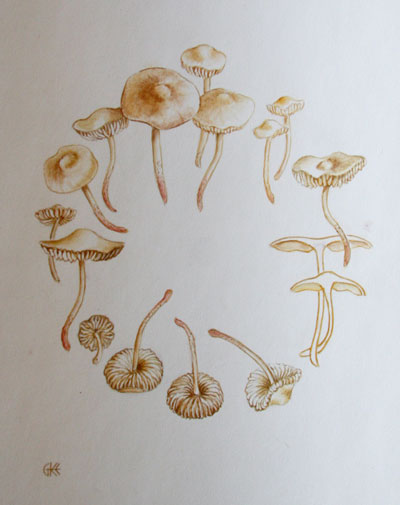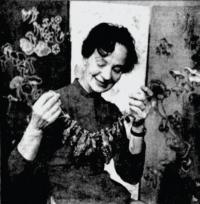These are tough questions to answer, but haven’t we all pondered them? I know that I, for one, have thought a lot about the work I’m doing today. I wonder if my work is making a positive impact on my community. Am I making a difference for someone or something? Fortunately, I have seen first hand the successful outcomes the Urban Ecology Center’s efforts have had in Milwaukee neighborhoods, and I can say my work helped fund and implement those programs and projects. But the question remains, what happens when I die? Will someone continue my hard work?
I want to share with you a story about Gertrude Erskine. Sadly, I never had the pleasure of meeting Tula, as she was known, but I learned of her not long after I started working at the Center. I share her story because it has helped me as I think about how what I do today can impact the future. While Tula may have never shared with anyone her thoughts regarding these important mortality questions, we know she contemplated them. I have seen how her decisions in life made an impact after her death, and now she is remembered by more than just the people that knew her during her lifetime.
Tula, a fancier of mushrooms, art, and nature, was a kind friend of the Center’s long before the current green building that stands in Riverside Park was constructed. She was also a fan of the vegetarian potluck, the first interest group at the Urban Ecology Center. Often arriving in an old worn sweater, Tula was welcomed among friends in the trailer. One can only guess what the conversations were about, but knowing Tula’s deep interest in fungi, there were surely discussions about what was in her dish.
 Tula was also deeply involved with the Mycological Society of Wisconsin (mycology is the study of fungi) leading field excursions, hunting for and identifying mushrooms, and then experimenting with them in her kitchen. Before picking and cooking the delights though, she would sketch detailed drawings of them in her journal. She was nearly an expert at identifying the specimens in and around the area. Her drawings were no simple sketches, either. Tula was an artist and teacher by trade, and so naturally she created such detailed drawings they could be used to help others learn about and identify mushrooms too. In fact, Tula’s works were shown at art shows around the city. (If you visit the Urban Ecology Center at Riverside Park, you can see some of Tula’s mushroom drawings and pre-Columbian sculpture rubbings.)
Tula was also deeply involved with the Mycological Society of Wisconsin (mycology is the study of fungi) leading field excursions, hunting for and identifying mushrooms, and then experimenting with them in her kitchen. Before picking and cooking the delights though, she would sketch detailed drawings of them in her journal. She was nearly an expert at identifying the specimens in and around the area. Her drawings were no simple sketches, either. Tula was an artist and teacher by trade, and so naturally she created such detailed drawings they could be used to help others learn about and identify mushrooms too. In fact, Tula’s works were shown at art shows around the city. (If you visit the Urban Ecology Center at Riverside Park, you can see some of Tula’s mushroom drawings and pre-Columbian sculpture rubbings.)
Despite her distinctive character and eccentricities: her red hair, her pipe, and her plant-filled yard, Tula lived a very modest life, enjoying simply the things she loved. And she did so passionately and openly.
On March 17, 2000 Tula passed away. A few months later the Urban Ecology Center received a phone call from her lawyer to notify the organization of her bequest. Tula had left the Urban Ecology Center and three other organizations a bequest of over $300,000 each! No one knew that in her 92 years, she had secretly accumulated such significant wealth in two hidden assets. Not even her closest friends or family knew about her wealth or her intentions for it, but like everything Tula did, it was a well-thought plan.
Whether she knew it or not, Tula’s gift was extremely critical to the Urban Ecology Center’s growth. It provided our young organization with savings that created an operational cushion. It was Tula’s gift, the “cushion,” that allowed the Urban Ecology Center’s board to risk embarking on a multi-million dollar campaign to build the award-winning green Center in Riverside Park. Our Executive Director, Ken Leinbach, credits this building and our progress to Tula, “I can honestly state that without Tula’s forethought and planning, we would not be here as we are today.”
Now, three branches strong and still growing and impacting the Milwaukee community and beyond, Tula’s legacy lives on in the Urban Ecology Center. And as the Center grows, we are dedicated to planning for a sustainable future. When I think or hear of Tula, I am continually inspired by her passion and commitment, and I look forward to working with others that share her commitment to the Center’s mission. I have devoted a portion of my role to building a program that recognizes and thanks donors like Tula during their lifetime. If you have included the Urban Ecology Center in your will or estate plans, I would love to hear your personal, unique story. You can reach me by email anytime, This email address is being protected from spambots. You need JavaScript enabled to view it. or phone (414) 964-8505 ext. 104.





